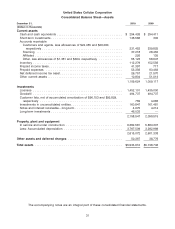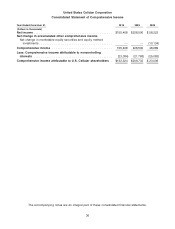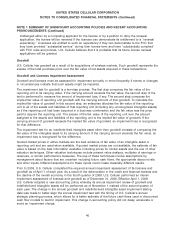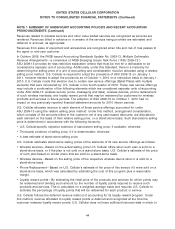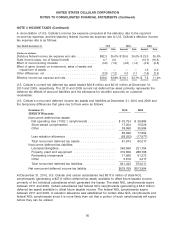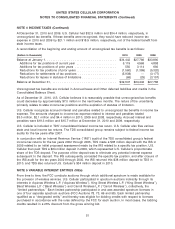US Cellular 2010 Annual Report Download - page 49
Download and view the complete annual report
Please find page 49 of the 2010 US Cellular annual report below. You can navigate through the pages in the report by either clicking on the pages listed below, or by using the keyword search tool below to find specific information within the annual report.UNITED STATES CELLULAR CORPORATION
NOTES TO CONSOLIDATED FINANCIAL STATEMENTS (Continued)
NOTE 1 SUMMARY OF SIGNIFICANT ACCOUNTING POLICIES AND RECENT ACCOUNTING
PRONOUNCEMENTS (Continued)
U.S. Cellular tests goodwill for impairment at the level of reporting referred to as a reporting unit. For
purposes of impairment testing of goodwill in 2010 and 2009, U.S. Cellular identified five reporting units.
The five reporting units represent five geographic groupings of FCC licenses, representing five
geographic service areas. U.S. Cellular tests licenses for impairment at the level of reporting referred to
as a unit of accounting. For purposes of its annual impairment testing of licenses as of November 1,
2010 and 2009, U.S. Cellular combined its FCC licenses into eighteen units of accounting. Of these,
thirteen of such eighteen units of accounting represented geographic groupings of licenses which,
because they were not being utilized and, therefore, were not expected to generate cash flows from
operating activities in the foreseeable future, were considered separate units of accounting for purposes
of impairment testing. The five units of accounting for which licenses are being utilized are referred to as
‘‘built licenses’’ and the thirteen units of accounting for which licenses are not being utilized are referred
to as ‘‘unbuilt licenses.’’
For purposes of impairment testing of goodwill, U.S. Cellular prepares valuations of each of the five
reporting units. A discounted cash flow approach was used to value each reporting unit, using value
drivers and risks specific to the current industry and economic markets. The cash flow estimates
incorporated assumptions that market participants would use in their estimates of fair value. Key
assumptions made in this process were the discount rate, estimated future cash flows, projected capital
expenditures and the terminal growth rate.
In 2009, U.S. Cellular changed its method of estimating the fair value of built licenses for purposes of
impairment testing from the multiple period excess cash flow method (‘‘MPECF method’’) to the build-out
method. U.S. Cellular elected to make this change as the build-out method is a more widely used and
accepted valuation method in estimating the fair value of licenses for purposes of impairment testing in
the wireless industry. U.S. Cellular does not believe the build-out method yields a significantly different
estimate of the fair value of licenses than the MPECF method.
The MPECF method estimated the fair value of the units of accounting by measuring the future cash
flows of the license groups, reduced by charges for contributory assets such as working capital,
trademarks, existing subscribers, fixed assets and assembled workforce to arrive at the economic
margin. A contributory asset charge for goodwill was subtracted from the economic margin to arrive at
the after-tax excess cash flows applicable to the licenses.
The build-out method estimates the value of licenses by calculating future cash flows from a hypothetical
start-up wireless company and assumes that the only assets available upon formation are the underlying
licenses. To apply this method, a hypothetical build-out of the company’s wireless network, infrastructure,
workforce and related costs are projected based on market participant information. Calculated cash
flows, along with a terminal value, are discounted to the present and summed to determine the
estimated fair value.
For units of accounting which consist of unbuilt licenses, U.S. Cellular prepares estimates of fair value by
reference to prices paid in recent auctions and market transactions where available. If such information is
not available, the fair value of the unbuilt licenses is assumed to change by the same percentage, and in
the same direction, that the fair value of built licenses measured using the build-out method changed
during the period.
Investments in Unconsolidated Entities
Investments in unconsolidated entities consist of amounts invested in wireless entities in which
U.S. Cellular holds a noncontrolling interest. U.S. Cellular follows the equity method of accounting for
such investments in which its ownership interest equals or exceeds 20% for corporations and equals or
exceeds 3% for partnerships and limited liability companies. The cost method of accounting is followed
41


